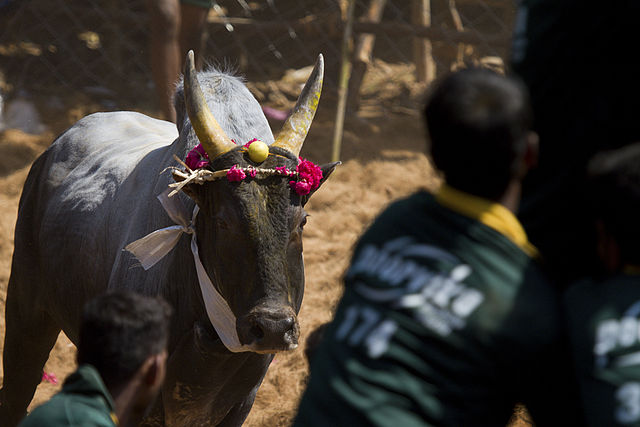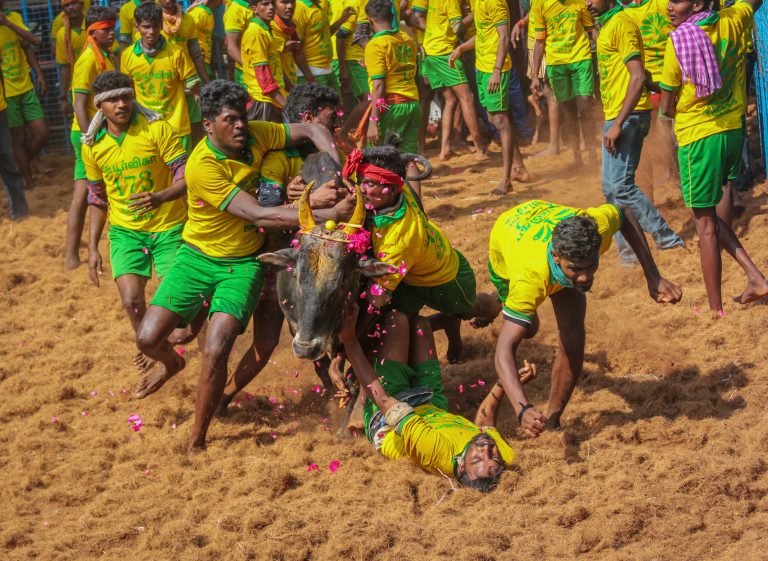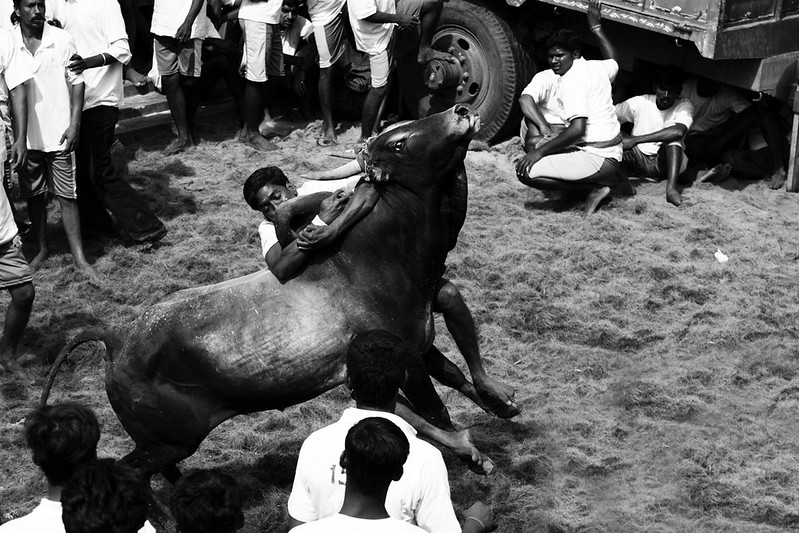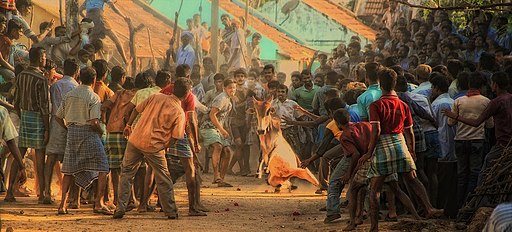History And Facts About Jallikattu Game
Written by Manya Pandey, a first-year undergraduate student.
Jallikattu is a bull-taming sport that’s played in the state of Tamil Nadu – during the festival of Pongal in January (Pongal is a three-day Hindu harvest festival that (traditionally) marks the end of the winter solstice.
Written by Manya Pandey, a first-year undergraduate student.
Jallikattu is a bull-taming sport that’s played in the state of Tamil Nadu – during the festival of Pongal in January (Pongal is a three-day Hindu harvest festival that (traditionally) marks the end of the winter solstice. Fighting bulls in Pongal are symbols of masculinity and social status.
About Jallikattu

Catch the bull’s hump or Jallikattu is a traditional festival that’s celebrated in Tamil Nadu. Some have named it a “bull taming” fiesta while others simply call it “sallikkattu”, its other traditional name.
The term ‘Jallikattu’ or Sallikattu is derived from Tamil. Simply put–’salli’ refers to golden or silver coins and “kattu” means ‘package’. Put together–it refers to coins being tied to the bull’s horns, which is considered the prize for whoever tames the bull. The participant has to grab onto the hump of the bull for removing the package.
The custom
During the ceremony, bulls of a good breed (usually domestic breeds like Pulikulam or Kangayam) are released in the midst of a crowd where people try to cling to their humps.
In order to win, the participants have to either stop the raging bull, or just hold on to its hump until they can remove the flags from the bull’s horn.
When is Jallikattu Celebrated?

It’s usually practised as a Pongal tradition on the Mattu Pongal day which is popularly known as Makar Sankranti. Pongal is a south Indian Festival held annually in January to mark the harvest season. Such festivals in harvest seasons are celebrated all around the Indian subcontinent but Jallikattu is unique to the Tamil Nadu state.
How to Play Jallikattu?

It’s an easy game with no complex rules but it sure requires a lot of courage to jump on a wildling bull and it is very dangerous. The bulls are strong enough to grievously injure the participants.
Here’s how you play Jallikattu
- A bull enters the arena through a gate called the vadi vasal (entry point)
- The participants have to try and hook onto the bull’s hump.
- The longer they hold on, the better their chances of winning.
- In some variations, the participants can even win by latching on to the bull’s neck, horns, or tail but in the most popular style only holding on to a hump qualifies as a part of the game
There are many ways to win the game, depending on the region.
In some areas, participants just have to hold on for 30 seconds or for about 15 meters to win. In other regions, you may lose if you fall off or get thrown by the bulls.
Interestingly there’s a peculiar rule in certain regions that if two people grab the hump, then neither person wins. Now that you know how to play Jallikattu, let’s move on to a short history of Jallikattu.
History Of Jallikattu

Fun fact- The history of Jallikattu dates back to the Sangam age, which means it has existed for over 400–100 BCE or over 2,500 years. Briefly, the Tamil classical period or The Sangam age refers to a time when Tamil Nadu, Kerala, and parts of Sri Lanka were one and were collectively known as Tamilakam.
It was a really popular game among the Ayar people (devotees of lord Krishna) who lived in the ‘Mullai’ or forest region of the Sangam lands. Their bull-taming festive traditions slowly evolved into the competitive known today as Jallikattu.
Curiously enough, the history of Jallikattu may have taken such a turn because it’s a perfect game to showcase bravery and one’s courageous spirit. Maybe it was the prize money that really encouraged participation. We can never tell because there’s much left to be unearthed about this game and only a very short history of Jallikattu’s origins is known to us.
Founder of Jallikattu
The Ayar people of ancient Tamil Nadu are mostly regarded as the creators of the game. The Ayars were a pastoral community of the erstwhile country Tamilakam.
Much like most traditional Indian games, there is no specific founder of Jallikattu, but a lot of variations are found in the state, which brings us to our next segment.
How did the local variations evolve throughout the history of Jallikattu

Over the course of the evolution of the short history of Jallikattu, three main variants have taken the top podium and have become the most regarded forms of the game, Vadi manjuviraṭṭu, the most common form of Jallikattu; Vēli viraṭṭu; Vaṭam manjuviraṭṭu.
Here’s a short description of each.
Vadi manjuviraṭṭu: This is the most common form of the game wherein the bull is released from a closed space (vadi vasal) and the contestants attempt to hold on to the bull’s hump. The game’s twist is that only one person is allowed to attempt it for a single turn.
An individual is allowed to go for multiple tries. Such gameplay is most common in the districts of Madurai, Theni, Thanjavur, and Salem of Tamil Nadu.
Vēli viraṭṭu: Unlike the former variant, where the bull comes running out of a closed space, in this one, the bull is released into the open ground, surrounded by a crowd of people. The rest of the rules are just the same. It’s more popular in the districts of Sivagangai and Madurai.
Vaṭam manjuviraṭṭu: This variant is more of a team sport. “Vatam ” in Tamil means circle, so in this form, a bull is tied with a 15-meter or about 50-feet-long rope therefore it can move unrestricted within that radius. A gift token is tied to the bull’s horn and a team of seven to nine members tries to untie it within a time slot of 30 minutes to win the game.
Let’s talk about the bull that’s involved in these games

Pulikulam bulls are often called the “kings of Jallikattu”. They are a domestic breed from Tamil Nadu and have been extremely important in the history of Jallikattu. In fact, one of their many names is “Jallikattu maadu”
(maadu is the Tamil word for cattle).
Other than that, a special breed of bull, scientifically known as Bos indicus or the Humped cattle, is specially bred by people of the Tamil villages for the annual event of bull taming.
The bulls involved in the game have to be a superior stock of bulls because they are later used to mate with the domestic cows. Through these procreations, healthy cows and oxen are made available for future generations.
Cows are very important for rural livelihood and the same goes for the bulls that are still quite prevalent in certain villages of Tamil Nadu despite all the technological advancements. Fortunately, the humped cattle fetch higher prices in the markets.
But is bullfighting cruel?

The animal rights association PETA – People for the Ethical Treatment of Animals- thinks so and has presented its case past photo and statistical with evidences.
They claimed that the bulls were whipped, poked, and hit to make them run toward the waiting participants. Some reports even claimed that the bull’s tails were bitten to agitate them before a game.
These bulls were harmed for human enjoyment. The ethics of allowing human culture to supersede animal rights was blurred in this sport.
Taking their plea into consideration, the Supreme court of India imposed a ban on the bull-fighting festival in the year 2014 saying that, even the bulls have rights against torture.
In fact, in the same judgment, the court banned the bull cart racing festival in Maharashtra. The short history of Jallikattu has seen a lot of bans because of the cruelty against the bulls involved in the game.
So is Jallikattu illegal now?
Jallikattu is a very dangerous game that risks serious injuries or even loss of life. In fact, there have been cases of death in the past which is also why the court banned it, but there is no denying that it’s an integral part of the Tamilian Pongal tradition.
You may already know this, but the Jallikattu game is no longer illegal because the state government of Tamil Nadu pushed an amendment(change) to the laws of animal cruelty. This amendment allows for the game to be played in accordance with a few legal conditions.
This amendment was approved by the President of India and thus overruled the Supreme Court’s ban on the festival. While many people including celebrities view it as a barbaric festival, farmers of Tamil Nadu hold a lot of cultural significance in the practice. They say it helps them pick out the best bull for breeding.
Though inhuman at times, Jallikattu is still an integral part of Tamil culture. The game should be played in a way that respects both human and animal rights.
With that, we bring you a list of fun facts about Jallikattu.
Some Facts About Jallikattu
1. Jallikattu is over 2500 years old, and archaeological evidence of the game’s past versions are preserved in the National Museum, New Delhi.
Archaeologists once excavated a seal from the Indus Valley civilization, demonstrating the practice of the Jallikattu game. This seal is kept in the National Museum, New Delhi for display. There also stands a cave near Madurai, Chennai that has a 1,500-year-old painting that depicts a man trying to control a bull quite similar to how it happens in the game of Jallikattu.
2. Jallikattu has stood two bans since 2014
The popular animal rights association PEETA wished for a ban on Jallikattu practice since 2004 and their wish was released in 2014 after the court took their immense studies and evidence into consideration and banned the practice but the people of Tamil Nadu retaliated and the ban didn’t last long but was imposed once again in 2017. It met the same fate as the 2014 ban.
3 The bull that wins is used to breed with several cows
This practice is to ensure the birth of healthy calves and also to preserve the health and fertility of the local breeds.
The bulls that win are believed to be of better quality as compared to the rest of the bulls.
4. What happens to the bulls that lose?
After the event, bulls that get tamed are considered weak and are used for domestic activities and agriculture.
Some quick facts about Jallikattu game
- It has three main variants, namely Vadi manjuviraṭṭu, Vēli viraṭṭu and Vaṭam manjuviraṭṭu
- In the former two, the bull is free to run and trample upon anything or anyone in its way, and in the last version, the bull is tied to a 50 feet long rope.
- Special strong calves are raised specially for the Jallikattu tradition.
- Temple bulls are often more preferred for the practice and are worshipped throughout the year on different occasions.
You May Also Like:
Facts and History of the Kabaddi Game
History and Facts of Ludo Game.
Facts and History of Hockey Game
Headline Image Credit: Ashit Desai
I Kid You Not now has a large readership across India and also parts of the world. If you want to write for us, you can submit your story here. You can also apply to become a news anchor. Apply here
Better Your Child’s G.K. In 3 Minutes – Get This Free Newsletter
Get fun facts, simple and easy news, quizzes, and lots of other interesting things to read in your mailbox – for free! It’s what we call GK-on-the-go!
Sign up for our free newsletter here




Comments